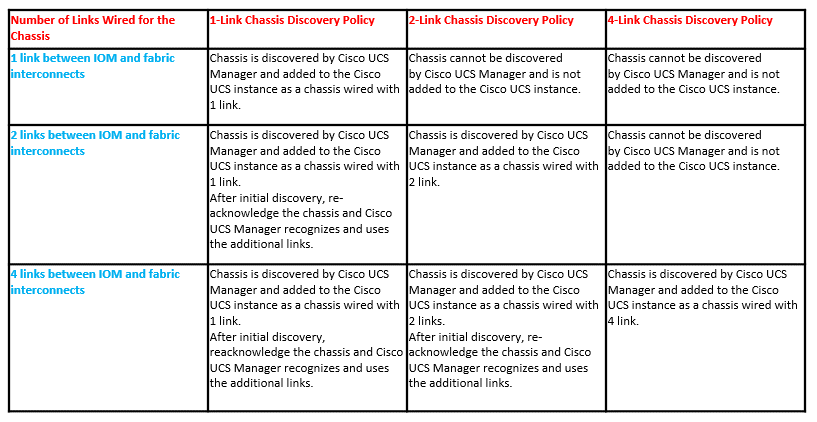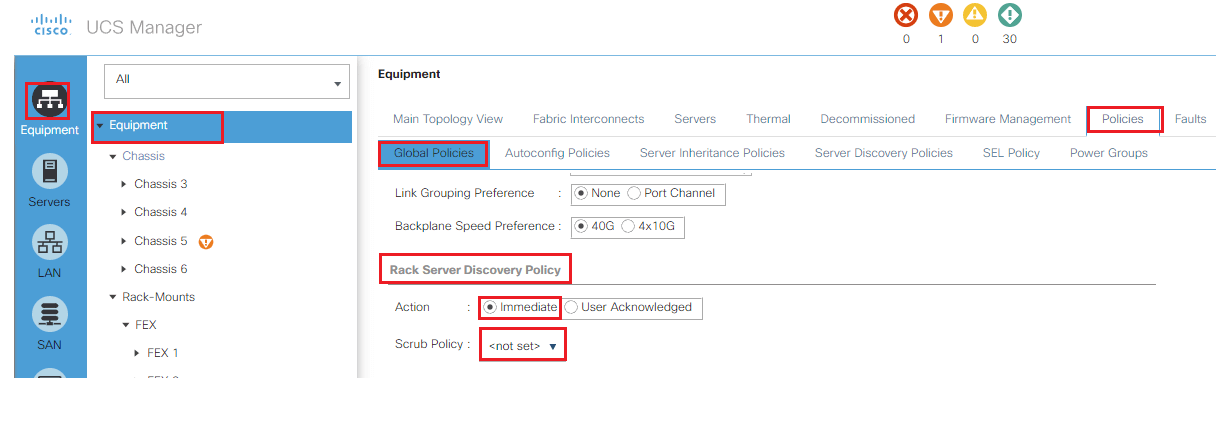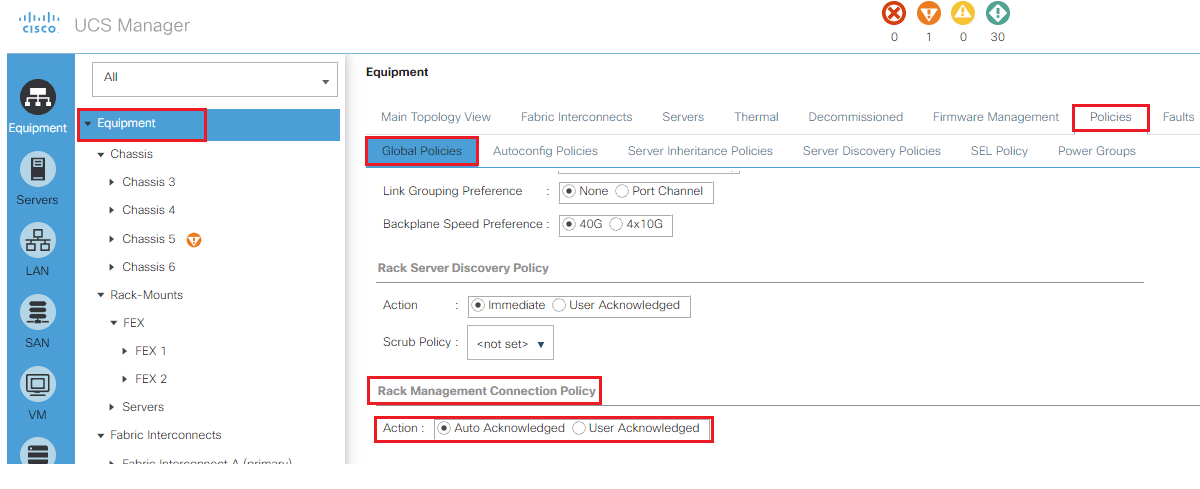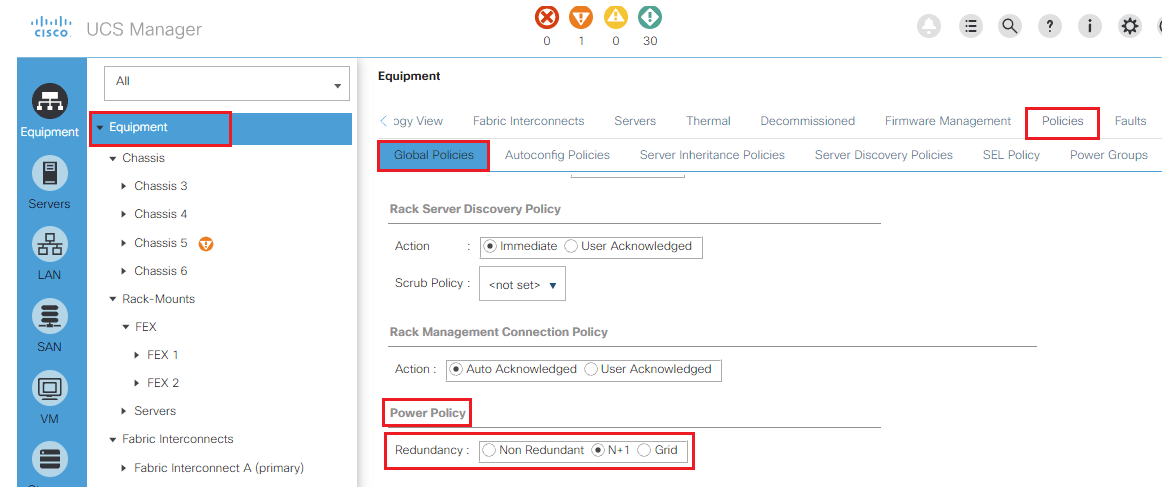EMAIL SUPPORT
dclessons@dclessons.comLOCATION
USUCS Global Configuration Policies
In UCS, there are few global policies and configuration that are not assigned to servers, but are necessary for proper functioning of all components.
These policies are mentioned below:
- Chassis/FEX Discovery Policy
- Rack Server Discovery Policy
- Rack Management Connection policy
- Power Policy
- MAC Address Table Aging Policies
- DNS Server Policy
- Time Zone Management
- SNMP Configuration
We will discuss each policy in detail, and learn what these policies do and how they function.
Chassis/FEX Discovery Policy
The chassis discovery policy determines how the system reacts when you add a new chassis. Cisco UCS Manager uses the settings in the chassis discovery policy to determine the minimum threshold for the number of links between the chassis and the fabric interconnect. However, the configuration in the chassis discovery policy does not prevent you from connecting multiple chassis to the fabric interconnects in a Cisco UCS instance and wiring those chassis with a different number of links.
If you have a Cisco UCS instance that has some chassis wired with 1 link, some with 2 links, and some with 4 links, we recommend that you configure the chassis discovery policy for the minimum number links in the instance so that Cisco UCS Manager can discover all chassis. After the initial discovery, you must reacknowledge the chassis that are wired for a greater number of links and Cisco UCS Manager configures the chassis to use all available links.
Cisco UCS Manager cannot discover any chassis that is wired for fewer links than are configured in the chassis discovery policy. For example, if the chassis discovery policy is configured for 4 links, Cisco UCS Manager cannot discover any chassis that is wired for 1 link or 2 links. Re-acknowledgement of the chassis does not resolve this issue.
Below table provides an overview of how the chassis discovery policy works in a multi-chassis Cisco UCS instance:

Procedure:
- In the Navigation pane | click the Equipment tab.
- On the Equipment tab | click the Equipment node.
- In the Work pane | click the Policies tab.
- Click the Global Policies subtab.
- In the Chassis Discovery Policy area, choose the number of links to be used by the chassis from the Action drop-down list. | Click Save Changes.

Rack Server Discovery Policy
The rack server discovery policy determines how the system reacts when you add a new rack-mount server. Cisco UCS Manager uses the settings in the rack server discovery policy to determine whether any data on the hard disks are scrubbed and whether server discovery occurs immediately or needs to wait for explicit user acknowledgement.
Cisco UCS Manager cannot discover any rack-mount server that has not been correctly cabled and connected to the fabric interconnects. For information about how to integrate a supported Cisco UCS rack-mount server with Cisco UCS Manager, see the hardware installation guide for that server.
- In the Navigation pane, click the Equipment tab.
- On the Equipment tab, click the Equipment node.
- In the Work pane, click the Policies tab.
- Click the Global Policies subtab.
In the Rack Server Discovery Policy area, complete the following fields:

Below figure explains about Rack Server Discovery Policy

Rack Management Connection policy
In order to configure the Rack Management Connection policy, follow the same step which we used for Chassis/FEX Discovery Policy and select Global Policies.
Select Appropriate Action option using radio button and click OK.

Power Policy
The Power Policy is used to specify the redundancy for power supplies in all chassis in UCS domain. This is also called as PSU policy.
In the power Policy area: There are below options:
Non-Redundant: UCS turn on Minimum number of PSU needed and then balances load between them. If any additional PSU are installed, UCS manager will set them to a turned-off state. If power to any PSU is disrupted, the system may experience an interruption in service until, Cisco UCS manager can activate a new PSU and rebalance the load.
N+1: The total number of PSUs to satisfy non-redundancy, plus one additional PSU for redundancy, are turned on and equally share the power load for the chassis. If any additional PSUs are installed, Cisco UCS Manager sets them to a "turned-off" state. If the power to any PSU is disrupted, Cisco UCS Manager can recover without an interruption in service. In general, a Cisco UCS chassis requires at least three PSUs for N+1 operation.
Grid: Two power sources are turned on, or the chassis requires greater than N+1 redundancy. If one source fails (which causes a loss of power to one or two PSUs), the surviving PSUs on the other power circuit continue to provide power to the chassis.
Below are steps to configure Power policy:
- Follow the same step which we used for Chassis/FEX Discovery Policy and select Global Policies.
- Select the required Redundancy option, which is dependent on the total number pf power supplies and power feeds to Data Centre.
- Click OK.

MAC Address Table Aging
Fabric interconnect dynamically builds the MAC address table by using the MAC source address from the packets received and the associated port on which the packets were learned. The fabric interconnect uses an aging mechanism, to determine how long an entry remains in the MAC address table. If an address remains inactive for a specified number of seconds, it is removed from the MAC address table.





LEAVE A COMMENT
Please login here to comment.